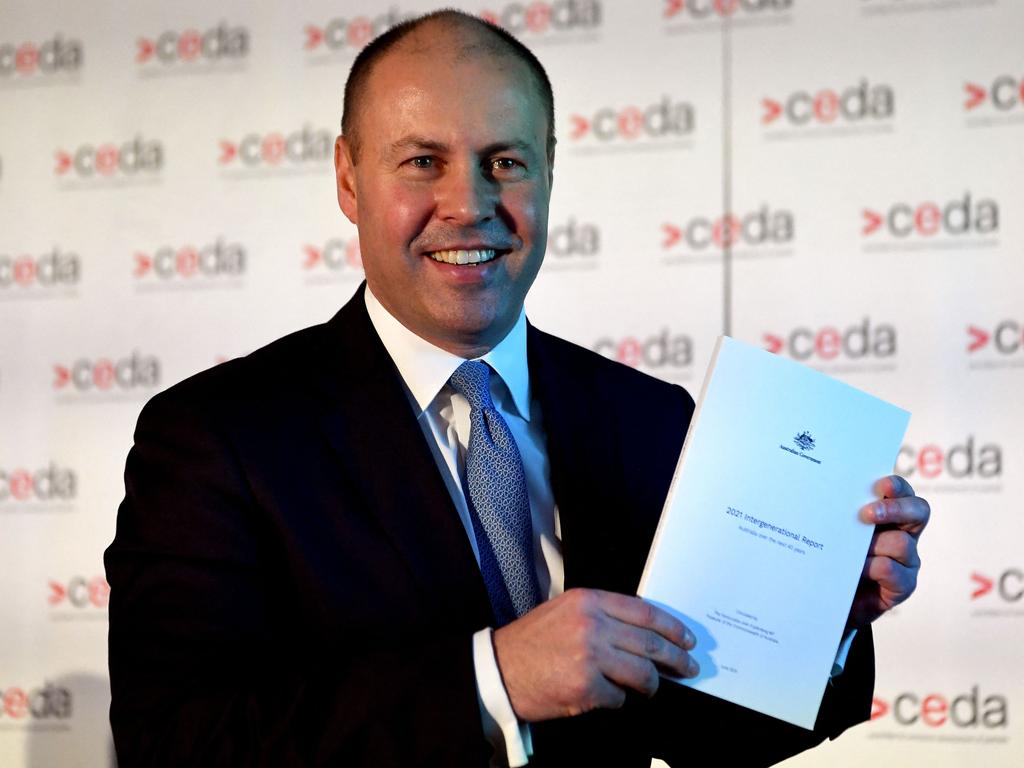Intergenerational Report: OK boomer, it’s time to pay for your extravagant ways
Prying away entitlements from warm, wrinkled hands will be a contest for the ages.

They don’t pay income tax, but they vote. Baby boomers are hitting peak wealth, leisure and mobility in their 60s and 70s, fresh from AstraZeneca jabs and a big shop at Kathmandu. For those who think regional high-vis seats are where elections are won and lost, think again. Meet the power of Big Grey.
Over the next 40 years, the number of Australians aged over 65 will double to nine million; the population aged 85 and over will triple to two million. In coming decades, a majority of voters will be aged 50 or above.
As the last of the boomers hit age 65, this time-rich, asset-heavy, and potentially well-organised interest group will form the frontline of puffer-jacket resistance to stop children of the 1970s, like Josh Frydenberg and Jim Chalmers, who will have no choice but to repair the budget and reinvent the economy.
Treasury’s fifth Intergenerational Report (IGR), released this week, presents a best-guess version of our 40-year fiscal and demographic horizon. It’s the frigid splash of water after a $300bn pandemic bender. The post-war baby bulge will see the old age-dependency ratio, working age people to those aged 65-plus, slide from 5.5 in 2000 to just above three this decade.
The graph lines on spending and population seem gentle but are inexorable: fewer taxpayers, health munching over one-quarter of the budget, spiralling aged care costs, deficits as persistent as gravity. While Treasury assumes no policy changes, it takes long-term aspirational liberties on productivity growth, migration and climate change that make the picture prettier.
The Treasurer knows doing nothing is not an option. How can a Liberal, mentored in the Howard-Costello era, tolerate fiscal lassitude? Tax and spend should not come naturally to a walking-talking toiler, saver and striver. This dalliance with Shorten Labor-lite is a spiritual dead end for someone on track to be the Liberals’ standard bearer.
Rebuilding fiscal buffers for the next crisis asks for more ambition and a faster growth engine. From the business lobby to the top echelon of the ecosphere, there’s now a direct appeal to voters about changing how we work, tax and use resources to raise living standards.
“The IGR shows the current tax system is not going to be sustainable,” Business Council chief executive Jennifer Westacott told reporters on a conference call this week. Tax reform does not simply mean lower rates, Westacott said, but optimising the tax mix so it is efficient and free of distortions, while addressing issues such as intergenerational equity.
The alternative is a nation that looks like a genteel care home: an economy shuffling in its orthopaedic runners, a society divided, less dynamic, living off past glories and carried by workers burdened with debt that was piled up in the lazy first half of the century. A nation in gilded repose. Think Canberra, without the night-life or Saturday sport.
Compared with other rich countries, Australia relies heavily on income tax for revenue. Right now, it accounts for 49.6 per cent of revenue; over the next 15 years it will rise to 53.1 per cent. According to the IGR, the share of total income tax filers who are net taxpayers has declined from 84 per cent in 1991 to 76 per cent in 2018.
“The majority of Australians of retirement age pay little or no income tax, and the proportion of older Australians who pay personal income tax has generally declined over time, largely due to the introduction of age-related tax offsets and changes to the taxation of superannuation income,” the IGR noted.
Compulsory superannuation means more retirees will rely on their own savings over coming decades, albeit with many taking part pensions. While the cost of age and service pensions will fall, health costs will rise from 4.6 per cent to 6.2 per cent of GDP in 2061, slightly less than previous IGR projections. Health will eventually eat up 26 per cent of the budget, up from the current 19 per cent.
Average per person usage of health services – hospitals, medical benefits and pharmaceuticals – takes off from age 55 and peaks in the 80-plus group. According to the Australian Institute of Health and Welfare, those aged 65 and over were four times more likely to have comorbidities than those aged 15 to 44.
The national average on pharmaceutical usage is akin to a 50-year-old male; a 25-year-old man costs taxpayers one-third of that, but an 80-year-old man costs 4.6 times the average. For medical benefits, the average patient is a 30-year-old woman; a tween girl costs one-third of that, while spending on her 80-something great-grandmother is three times the average.
Sure, rich countries are entitled to opt for expensive medical technologies and lifesaving drugs, such as vaccines. We choose life, the longer the better. But it has to be paid for, by someone younger, which is okay to a point.
In its Living on Borrowed Time paper released after the IGR, the BCA proposes taxing the elderly to ease the tax squeeze on younger workers, arguing both wealth and income need to be taken into account when assessing the capacity of individuals to contribute to the cost of services.
“We must avoid the situation where an average earner struggling to get on the property ladder is subsidising the costs of a retired person who has millions of dollars’ worth of assets,” the BCA paper says.
The Grattan Institute’s chief executive Danielle Wood believes the IGR should be used to spark action, not only scare us. Among a range of reforms, Wood argues the government should wind back the policies that supercharged the effect of the ageing population on public finances.
“Tax-free superannuation income in retirement, refundable franking credits, and special tax offsets for seniors mean we now ask wealthy older Australians to contribute a lot less than we did,” Wood writes in The Conversation.
“An older household earning $100,000 a year pays on average less than half the total tax of a working-age household earning the same amount.”
Although the IGR makes it clear this is not sustainable, Wood says successive governments have been “reluctant to shift the dial”. Labor scratched away at intergenerational equity at the 2019 election by proposing to end cash refunds for “excess franking credits”. “If they feel that this is something that should impact on their vote they are, of course, perfectly entitled to vote against us,” Labor’s then Treasury spokesman Chris Bowen told retirees in the lead up to the poll. Voters obliged.
How do we fix this without electoral bloodshed? Frydenberg wants to grow the economy and raise its speed limit, keep taxes below the 23.9 per cent of GDP ceiling, and get more value out of government services. Expect the Treasurer to talk more about “outputs” rather than “inputs” in coming speeches. You can hear an echo of this already from the Coalition backbench, with constituents highly attuned to any hint of austerity cuts or reduction in service quality.
The Morrison government’s response to aged care in the budget may be a guide. So-called “non-market services” represent 21 per cent of economic activity and 29 per cent of employment. While human services improve wellbeing and reduce inequality, they are the next frontier to get big licks of productivity growth.
In a post-budget speech Treasury secretary Steven Kennedy outlined four principles for efficient and effective delivery of services: to provide users with more choice, improve competition, set efficient prices, and improve accountability and governance. Canberra knows it must set better incentives for its state partners and providers.
Frydenberg declares he’s an incrementalist. The Big Bang reform era is behind us, macropods and micro-crats, take note. Activist Liberals, however, see tax reform as the brave, new frontier, for company and personal tax, with a switch in the tax mix and less reliance on bracket creep to improve the bottom line. The Treasurer hasn’t given up on workplace reform, despite the legislative and ideological hurdles.
Both major parties will be attuned to better regulation, improving skills, getting superior outcomes on the gazillions taxpayers spend on infrastructure, and competition policy, which has delivered dividends from the ’90s. A Treasury paper released with the IGR reveals the high levels of pricing power and market concentration of big companies, leading to a lack of dynamism and poor productivity performance across industries. More needs to be done to make it easier for new players and innovation to thrive.
Given the ruthless fiscal pressure outlined in the IGR, and the political muscle of the “grey vote”, trimming social spending will be an arena for blood, sweat and tears. Who will be game to try? Prying away entitlements from warm, wrinkled hands will be a contest for the ages.








To join the conversation, please log in. Don't have an account? Register
Join the conversation, you are commenting as Logout